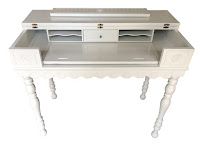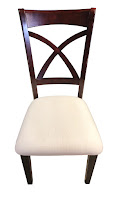 |
| China Cabinet Before |
Wow! This was a big job. Lots of pieces and lots of work,
 |
| China Cabinet After |
attention to detail and planning. A traditional dining set which was selected to be painted for an updated look to match our customer’s new home. The wood tone no longer suited and after selecting various stains in light shades, we moved into a different direction; paint. With thousands of paint colors available with as many names to match, we ended up with “Dorian Gray,” by Sherwin-Williams. It was a great color; light enough to look fresh but not super bright as white would have been.
 |
| Hutch Before |
The China cabinet had a lot of curves and detail, so the doors and
 |
| Hutch After |
drawers were removed and the entire cabinet was sanded, primed and painted, interior and exterior. The hardware was also painted in an accent gunmetal gray metallic, which looked splendid with the new paint in a high gloss finish. The hutch got the same treatment. The color really brought out the carving and details of the pieces.
The other challenge was the six chairs, including two armchairs. These had been re-upholstered many years ago with leather with decorative brass nail heads, but it wasn’t what our customer wanted, I suggested double welting instead of decorative nails.
The chairs took a long time just to remove the fabric, three hours per chair. There were so many nail heads and beneath them, a million or so staples and smaller nails holding the previous leather in place. It was a very time consuming job leaving Jim and I both with sore hands and shoulders. After that each chair had to be masked off on the seat area, sanded, primed and painted. After they dried, they were ready for fabric, which was custom ordered. While waiting for the fabric, I added decorative detailing paint to the top center of each chair, to highlight the scallop design. It tied both the light and dark gray colors together and matched the painted hardware. It’s fun adding “bling” to a project.
 |
| Armchair After |
 |
| Armchair Before |
The fabric our customer chose was a dark gray plush with a nap and was gorgeous for the freshly painted chairs. Cutting fabric has a sequence. First you need to cut a piece about 4” larger than the area you are covering to allow movement and positioning.
If the fabric has a pattern, you’ll want to pay attention to the focal point and place the pattern in the center of the seat, working around it to center it prior to attaching it. You tack it in place then stretch it to center it. It’s essential to carefully cut around the arms of the chairs so that you aren’t short. You cut in a “Y” seam perpendicular to the chair’s arm. Precision is key here. Once the fabric is stretched into place, have a pneumatic stapler ready and loaded is essential to get the job done efficiently. It’s my new favorite tool.
The dining room table had three leaves, which made it a fairly large piece. Painting large surfaces requires patience and a lot of skill. The glossy finish was perfect for this classic design. What a difference!
This was a lengthy job with many challenges, but we love how it turned out and that’s the ultimate reward.
 |
| Table Before |
 |
| Table After |
 |
| Chair Before |
 |
| Chair After |



















































